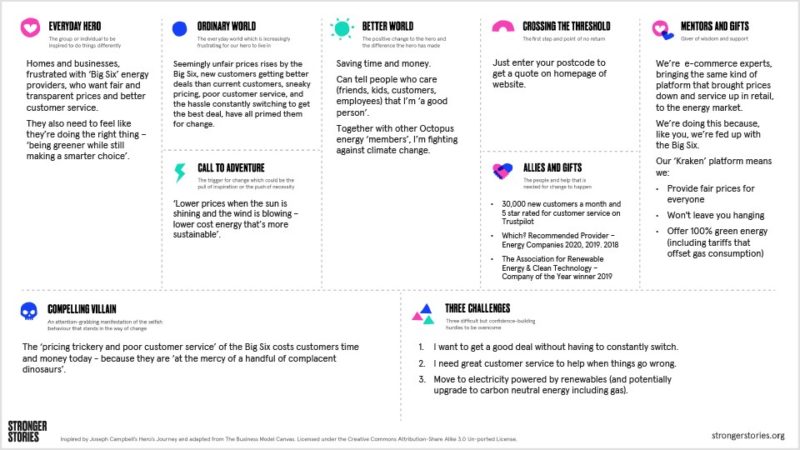Using story as strategy to grow your green business
“If a company doesn’t have a story. It doesn’t have a strategy. Storytelling is the most underrated business skill today.”
Ben Horowitz, Silicon Valley based entrepreneur turned investor ($7.1bn under management)
Ben Horowitz clearly knows a thing or two about growing businesses faster; he co-founded and served as CEO of enterprise software company Opsware (which Hewlett-Packard acquired in 2007 for $1.65 billion in cash); and is co-founder of a private American venture capital firm Andreessen Horowitz, which has invested in Skype, Facebook, Groupon, Twitter, Airbnb and Stripe.
It’s not just Horowitz who thinks this. Many of the world’s most successful businesses (such as Microsoft, Nike, 3M, Berkshire Hathaway, FedEx, and Proctor & Gamble) and high profile business schools (such as Notre Dame and De-Paul University) highlight the importance of storytelling as a critical leadership tool.
Stronger Stories has worked with sustainable entrepreneurs for 10 years. Drawing on this experience, we’ve developed an online story acceleration programme and tools to help climate-conscious businesses learn how to use ‘story as strategy’ to accelerate their growth.
Why story as strategy is particularly important to the growth of green business
The most important function of stories in our social evolution is making us feel in control of our interactions with other people. For over 70,000 years; gossip, fables and shared myths (from religion to money) helped us feel like we could navigate the world around us.
As a result our hyper-social brains are hardwired to unconsciously and constantly try to read and understand the minds of others. Whoever you’re communicating with, they’re subconsciously asking themselves “Who is this person? What is this company? Can I trust them? Do their ideas fit with my values?”
They are also asking themselves “Why?”. Why should I buy this product, invest in this company, tell my readers about this innovation, apply for this job? Why is the world better off as a result of this company’s existence?
Product features, financial projections or strategic objectives don’t answer this core question: the only thing that can is the well-told story of a company.
Perhaps this is best expressed by Bill Gurley of Benchmark Capital, considered one of technology’s top deal makers. For him, “the great storytellers have an unfair competitive advantage. They are going to recruit better, they will be darlings in the press, they are going to raise money more easily and at higher prices, they are going to close amazing business developer partnerships, and they are going to have a strong and cohesive corporate culture. Perhaps more to the point, they are more likely to deliver a positive investment return.”
This is especially important for green businesses who are often asking customers, investors, employees or partners to embrace new ideas and different ways of doing things. Our story-seeking brain’s mission to feel (from an evolutionary perspective) in control of the world around us means that we are inherently suspicious of even positive change. Fortunately, there are ways to ensure that the journey of change that your innovation represents is irresistible.
The pattern behind the world’s strongest stories
One way to overcome this unconscious suspicion of change is to use story patterns we instinctively understand.
Cognitive psychologists such as Larry L. Jacoby have studied the effects of familiarity on our perception of truth. They discovered that the more familiar information feels the more likely we are to perceive it as true. Whilst this cognitive bias is bad news for the fabric of democracy in the age of unregulated social media, it is good news for storytellers. Using familiar story patterns that our brains unconsciously recognise significantly strengthens a story’s sense of familiarity, and makes it a much more persuasive invitation to take action.
Perhaps the most familiar story pattern you can use is known as the ‘Hero’s Journey’. It was presented as ‘the monomyth’ – the consistent story pattern behind all our most compelling and enduring stories – by mythologist and lecturer Joseph Campbell in his seminal 1949 book The Hero with a Thousand Faces.
Campbell’s research, conducted in the earlier part of the 20th century, studied religious, spiritual, mythological and literary classics (and his resulting analysis was somewhat enthno- and androcentric) but his pattern can be observed in everything from the latest Hollywood blockbusters to the stories of Clean Growth unicorns. It is so deeply familiar that the last time you told a story around a watercooler or in the pub, you probably used the Hero’s Journey – you just didn’t realise it.
Our Lean Story Canvas merges the functionality of Strategyzer’s Business Model Canvas with Campbell’s Hero’s Journey. It focuses on 9 steps that make for a particularly compelling story in the context of story as strategy; from identifying an ‘Everyday Hero’ (typically your customer) and ‘Crossing The Threshold’ (the moment your customer commits to buying your product), to the ‘Better World’ that awaits them when they do. This allows us to identify the strengths and weaknesses in a company’s story, so that green entrepreneurs can optimise their story for growth and learn from the experience of those who have gone before them.
Story as strategy in action: Octopus Energy
Let’s look at how Octopus Energy have successfully taken their customers on a journey of change from ‘The Big Six’ to this now ‘Unicorn’ challenger brand.
The phrase ‘challenger brand’ is a story unto itself: with just two words you get the dramatic ingredients you need for an engaging story – a protagonist and an adversary. Challenger Brands are usually represented by a feisty underdog locked in a binary battle that is universally recognised. Small vs. Big, Good vs. Evil, Us vs. Them.
‘Octopus vs. The Big Six’ might sound like a terrible B-Movie you’d find languishing at the bottom of a bargain bin at a local service station, but trust us, it’s a story worth studying.

In May 2020, Octopus Energy became one of Europe’s Clean Growth Unicorns – with a valuation of over £1 billion. With operations now in Germany, Japan, Australia and the USA. The group’s mission to drive the affordable green revolution is going global.
Octopus bills itself as a tech-focused energy supplier as all of the electricity the company provides to its customers comes from renewable energy sources, but Octopus Energy’s chief technology officer, James Eddison, is the first to admit that when the company launched in 2016, its founders did not “necessarily know the energy market well” but could tell it was a sector ripe for disruption.
For decades the market had been dominated by ‘The Big Six’, a handful of incumbent household energy providers. In 2004 these companies held a combined market share across both the electric and gas markets of 100%.
Flash forward to 2021, Octopus Energy now supplies energy to 1.5 million homes in the UK and its ‘Kraken’ platform now supports over 17 million energy accounts.
Let’s take a closer look at three practical insights from the story of Octopus Energy.
- Don’t be afraid to call out your competition
The clue is in the title – being a challenger brand involves challenging others. It’s a bold and brave move and isn’t to be taken lightly.
Octopus Energy does just that, by referring to the Big Six as ‘a handful of complacent dinosaurs’. This call-out creates a self-selecting dichotomy for their customer. Nobody wants to be contracted to a side heading towards extinction, they want to be running with the plucky, nimble underdogs in the market.
Octopus goes on to show that ‘pricing trickery and poor customer service’ is costing customers time and money today. This creates a sense of urgency for customers and investors. This tactic goes one step further in focusing on the problems that the Big Six have created – it’s not just an intangibly broken market filled with monopoly grumbles, but now a pressing concern personally affecting the public.
- Have a personality
Octopus Energy is good at giving people a sense of the people behind the brand. This technique appeals to audiences on a personal level over the Big Six because they are creating human-to-human connections, rather than brand to consumer connections.
As a result, Octopus Energy is seen not just as a product or service, but a fully formed character. They aren’t a faceless corporation, but personal Mentors to customers who have welcomed their services into their home.
Octopus Energy includes a personal message from their founder on the website. He speaks like a human not like a CEO!
- Keep the Story Moving
Staying fresh and engaging as a disruptor on the scene is not an easy task – a challenger needs to keep moving to stay the same.
Being a challenger is a state of mind, not just a state of market. You need to make a commitment to continue to overthrow expected behaviour in the market and stand for making change that gives a maximum return on impact as well as investment. After overcoming one monster, narratives need to change, alongside public ambition, to keep the story compelling. Once Goliath is defeated, what next?
The point being – challengers can never be seen to win. We only root for an underdog when there is a more powerful foe waiting in the shadows.
So, what can Clean Growth Entrepreneurs learn from Octopus Energy’s story?
Have you successfully identified the Villain in your story? Present your brand as a business that is set out to rectify injustices in some kind of way. There will be criticisms – as is to be expected in any disruption process – but true challengers, and prospective investors, will find ways to thrive off the resulting controversy.
Does your organisation have a personality? The only way to stand out from an established sector is by having a robust, authentic brand identity. This means clearly defining who you are and speaking in a language that lets customers know what you intend to change in the market.
Make sure you write like a human! It doesn’t matter if you’re B2C or B2B, talking to customers or investors – you’re communicating to people. And those people want to know that you understand and empathise with their problems, and they want to know that your business can help solve them. They need to understand you to be able to do that.
If you’re a competitor, keep competing. Narrow down the arenas where you think you can continue the fight and make the choices that are right for you. Whether that be selecting markets, customers, channels, product categories, or vertical segments.
Next steps
Sign up to the Clean Growth UK & Stronger Stories workshop on 4 February
In the session, we’ll explore:
- The power of storytelling to inspire change
- The pattern behind the world’s most enduring stories of change, using examples from popular culture, Clean Growth businesses and the sustainability movement
- How you can use story as strategy for your own company’s growth
This interactive workshop will give you great insights and practical tools that you can apply to your own storytelling.
